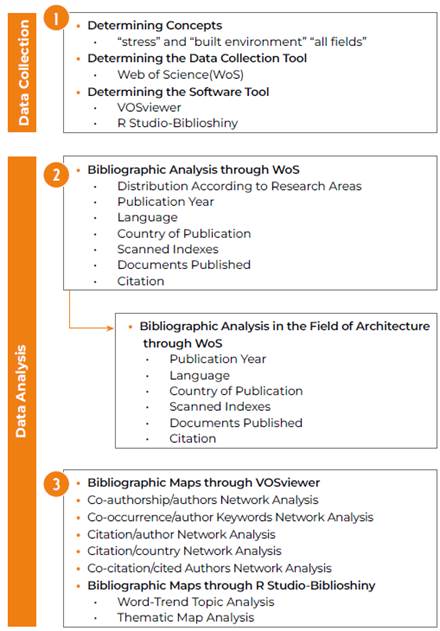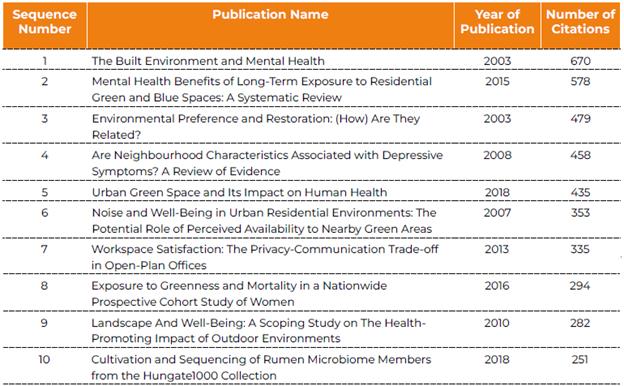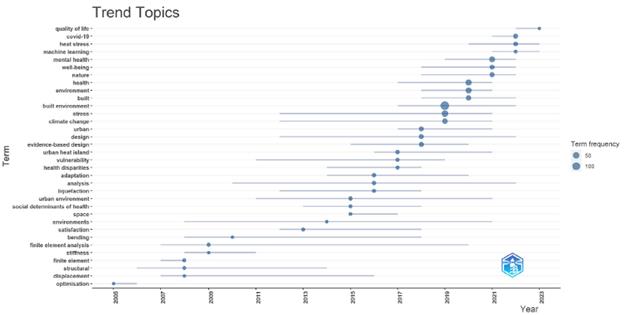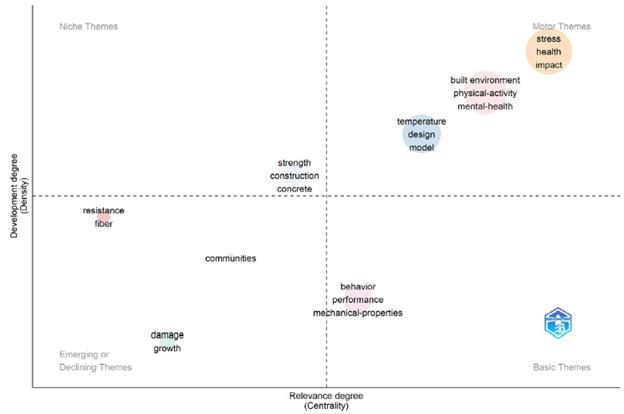INTRODUCTION
Modern times have begun to be called the age of stress, as stresses that deeply affect human life, such as mourning, separation, and illness, as well as daily stresses like work stress, urban stress, and hospital stress, have gradually increased. This situation, which causes diseases that negatively affect health and can result in death in later stages, appears as a health problem that needs to be emphasized in every field, and solutions should be developed.
The concept of stress, which has multifaceted and complex meanings, has been used in many branches of science, such as medicine, psychology, and sociology, from the past to the present. Used in the past to mean trouble, disaster, power, pressure, and difficulty, it has also been expressed as the basis of poor health as time progresses (Cofer & Appley, 1964; Lazarus & Folkman, 1984; Ünlü, 1998). In fields such as engineering and physics, it is stated as the resistance and tension of the substance, material, or structure (Umamaheshwer Rao et al., 2016). Stress, a pandemic public health problem (Beil & Hanes, 2013), is defined as the body's non-specific response to any demand placed on it (Selye, 1976). While stress affects the body's well-being, it also causes energy depletion and a poor quality of life (Baum et al., 1985). Besides, environmental stimuli such as poverty, crowds, and noise cause stress. In this case, stress also occurs when human-environment interaction results in a negative experience (Bilotta & Evans, 2015). In architecture, the discipline of designing healthy, comfortable, and safe spaces for people, researchers have tried to establish relationships between stress and the built environment from an interdisciplinary approach. They have studied how people cope with environmental stressors and react to stimuli (Rapoport, 1978; Rashid & Zimring, 2008).
Research on nature has determined the basis of the relationship between humans and the environment. Various studies have proven that the built environment affects people physically and psychologically (Göregenli, 2010; Günal, 2006; Morval, 1985). While the built environment can become a stressor, it can also contribute to reducing existing stress with some precautions (McEwen & Stellar, 1993).
Stress, which depends on environmental sensation, organism, and cultural factors, has a cumulative feature. Different lifestyles, perceptions, cultures, quality of life, and events can also create differences in stress levels. According to Ünlü (1998), the freedom to choose the built environment and the suitability of the built environment for the person show the qualities of the physical pattern. The level of stimulus in the built environment can affect people differently. While low stimulation may cause the environment to be perceived as ordinary, tedious, or gloomy, excessive stimulation may cause a lack of concentration and distraction (Kutlu, 2018).
As the researchers began to discuss the effects of the built environment on human health, it seems that theories and design approaches have emerged to reduce stress or cope with existing stress in architectural surroundings. These are Psychoevolutionary Theory (Ulrich, 1983), Healing Environment (Ulrich, 1984), Salutogenic Approach (Antonovsky, 1987), Stress Reduction Theory (Ulrich, 1983), Restorative Environment (Kaplan, 1995), Samueli Institute-Optimal Healing Environment (Ghazali & Abbas, 2012), and Supportive Design Approach (Dilani, 2008). Ulrich (1984) carried out studies in this field, developed various theories and approaches, and associated his studies on nature regarding stress to the built environment. His studies concluded that the natural environment and landscapes were good for negative situations like stress. He emphasized that the characteristics of nature should be associated with the built environment. In addition, various researchers have stated that spaces that encourage and engage people both mentally and socially are away from noise, benefit from daylight, are supported by aesthetic and artistic elements, and provide confidence have positive effects on stress (Dilani, 2015; Eriksson, 2016; Heerwagen et al., 1995; Karaca, 2018).
In addition to scientific studies on stress, limited bibliometric studies evaluate data on the subject. Some of these include studies in the scientific area of neuroarchitecture, another approach suggesting that the built environment's stress-causing parameters affect human physical health (Ghamari & Sharifi, 2021; Ghamari et al., 2021). However, more detailed studies on the subject have not been conducted. In this regard, the framework of the study is to show the development of the relationship between stress and the built environment over the years in the scientific literature to emphasize its importance in the built environment because stress is a concept on the agenda and closely related to health and to identify the most discussed and missing points. In this context, the study aims to perform a bibliometric analysis of the scientific literature by questioning the concepts of "stress" and "built environment" together. Thus, information has been obtained on the main topics and discussion areas regarding stress and the built environment in the scientific field, the influential countries and authors in the field, the essential publications in the literature, and the most used keywords by year.
Depending on how stress is perceived, it has positive or negative effects on the person, which are manifested through the built environment, or in other words, architecture. Considering the built environment's impact on human-space interaction, the place of architecture studies in the scientific literature is also important. For this reason, additional analyses were conducted to determine the place of architecture within this field and its prominent publications.
Bibliometric analysis is a method involving statistical data to evaluate the development trends of the current situation in a scientific field and to predict their future direction (Biswas et al., 2021; Okubo, 1997). Researchers use bibliometric methods to create structural images of scientific fields and contribute to creating objective sources for evaluating scientific literature (Storer & Crane, 1977). Bibliometric methods have two areas of use: performance analysis/bibliographic analysis and science mapping/bibliographic mapping. While performance analysis reveals the publication performance of authors and institutions, science mapping reveals the structure and variables of the scientific field (Zupic & Cater, 2015). Bibliometric research is carried out in many fields based on particular databases such as WoS, Scopus, PubMed, DBLP, and Google Scholar (Biswas et al., 2021).
Software tools developed to perform bibliometric analysis are Excel, Bibexcel, Sitkis, CiteS-cape, IN-SPIRE, CitNetExplorer, SciMAT, Sci2, VOSviewer, HisCite, Gephi, Pajek, UCINET, iGraph, and Biblioshiny (Emsen, 2022; Gürel, 2022). These programs may or may not work, depending on their file extensions. In addition, the program must be supported by another piece of software (Emsen, 2022). The analyses of this study were completed using VOSviewer 1.6.19 software and Biblioshiny-R Studio for visual richness purposes.
METHODS
Bibliometric analysis, a quantitative research method, was used in the study. The bibliometric analysis method, a crucial step in identifying gaps in the fields, is becoming increasingly common as it reveals the parameters that determine the quality of research (Abdullah & Sofyan, 2023). Recently, as in many other fields, there have been studies in which bibliometric analyses are made in architecture (Burkut, 2023; Varshabi et al., 2022). The study aims to perform a bibliometric analysis of the scientific literature by searching the concepts of "stress" and "built environment" together. In this context, since the study will determine the place, trend, and effectiveness of publications containing the stress-built environment relationship in the world literature, it is thought that the study will contribute to similar studies to be conducted in the future and will be a guide for researchers who will design research in this field. The study consists of data collection and analysis stages. We determined research concepts, data collection tools, and software tools in the data collection stage. In the data analysis phase, while the bibliographic analysis phase consists of analyzing the information obtained from Web of Science by converting it into a table, the bibliographic maps phase includes analyses on maps obtained through VoSviewer and Biblioshiny-R Studio (Figure 1).
Data Collection
The data collection process was performed in the Web of Science database between 1 and 31 July 2023 for reasons such as providing comprehensive content from different disciplines, covering high-impact journals, being able to scan, providing quality analysis content, and being widely used (Li et al., 2018). As a result of the research conducted by selecting "all fields" in the WoS database and using the keywords "stress" and "built environment" together, we reached 1,157 scientific publications. Since the concept of stress is interdisciplinary, there was no category limitation. Moreover, there were no restrictions regarding publication year and scientific publication type during the search. In addition, a narrowing process was carried out to examine the publications in architecture, reaching 36 publications.
VoSviewer and Biblioshiny-R Studio software were preferred in the study to provide more functional, larger, and higher quality maps and to create different visual richness. VOSviewer was designed to create and visualize bibliometric networks (Van Eck & Waltman, 2010). Additionally, the software, run online via the web page (Moral-Muñoz et al., 2020), enables scientific research to be conducted together with existing or researcher-generated data by using data such as author, country, journal, citation, and keywords, and researchers can use the program for network visualization, overlay visualization, and density visualization analysis (Abdullah & Sofyan, 2023; Van Eck & Waltman, 2010).
Biblioshiny combines the ease of use of Bibliometrics and Shiny programs, making it possible to perform analyses and visualize documents obtained from various databases (Huang et al., 2021). The program, running through RStudio, is frequently used because it offers high data visualization options (Aria & Cuccurullo, 2017).
Data Analysis
Data analysis was discussed under performance (bibliometric) analysis and science (bibliographic) mapping. In the bibliometric analysis of scientific publications on stress and the built environment, we created tables regarding the distribution of studies according to research areas, publication year, language, country of publication, publication category, publication type, publication indexes, citations, and published sources through data obtained from the WoS database. In addition, a bibliographic analysis of studies conducted in architectural science was also carried out. The study's publication year, country of publication, publication category, publication indexes, citations, and published sources were obtained from the WoS database, and the results are presented in tables.
The bibliographic mapping section visualized the data obtained from the WoS database using VoSviewer and Biblioshiny-R Studio software. Common author network analysis, co-occurrence keyword network analysis, authors' citation network analysis, countries' citation network analysis, and authors' co-citation network analysis were achieved through VoSviewer software. Co-author analysis is called the concrete expression of collaborations in scientific research. Co-occurrence keyword analysis refers to the concepts used in the publications considered to be central in the publications examined. As the frequency of the occurrence of concepts increases, the strength of the connection increases. Citation analysis was used to classify publications, detect their spread in the network, and reveal their relationships with each other. Analyses were performed specifically for authors, institutions, and countries (Arslan, 2022).
Researchers analyzed Trend Topic and Thematic Map using Biblioshiny software. In Trend Topic analysis, you can see how frequently keywords are used according to years. Dark and large circles with a color tone going from light to dark in different sizes show high density. The authors applied a clustering algorithm to the keyword network in Thematic Map analysis. Each cluster is represented on a graph of centrality, density, and the form of four themes. The motor theme represents the highly efficient group and is the strongest in the literature. The niche theme is widely used but not central; the simple theme is the central group that is not used much, and the developing or disappearing theme shows the group with low centrality and density (Bibliometrix, 2023).
RESULTS
Bibliographic Analysis Results
With the keywords determined by selecting "all fields" in the WoS database, the search obtained 1,157 scientific publications published between 1991 and 2023. When examining the publications, we found 821 articles, 230 proceedings, 108 review articles, 21 early access articles, 16 book chapters, nine editorial content pieces, one data paper, and one letter from a different discipline (Figure 2).
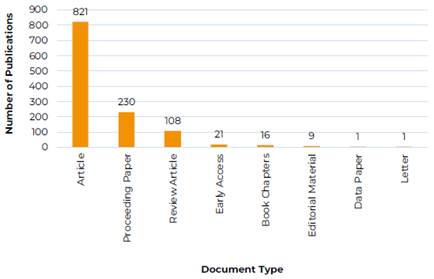
Source: visualized in Microsoft Excel based on WoS database results (2023).
Figure 2 Distribution of publications by document type.
When the distribution of the publications obtained from the research with the keywords "stress" and "built environment" was examined according to research areas, most publications were made in engineering, with 395 publications, and construction technology, with 297 publications. There were 271 publications in public environment and occupational health, 247 in environmental sciences and ecology, 102 in materials science, and 87 in science, technology, and other subjects. Architecture ranked 13th with 36 publications (Figure 3).
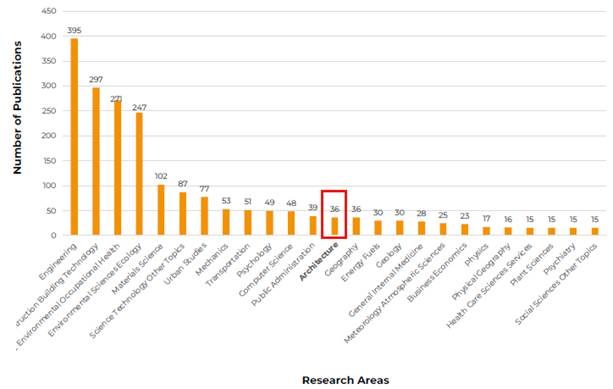
Source: visualized in Microsoft Excel based on WoS database results (2023).
Figure 3 Distribution of publications by research area
There has been an increase in recent years when the distribution of publications by year was examined (Figure 4). As of 2017, publications in the last seven years constituted 64.4% of the studies conducted between 1991 and 2023. While the number of publications was in single digits between 1991 and 2004, it increased to double digits between 2005 and 2018. While the publications were high in 2022, they were low in 1991-2000. The severe increase in publications in 2019 and 2022, especially in social sciences and humanities, has been inevitably related to the pandemic the world experienced in 2019.

Source: visualized in Microsoft Excel based on WoS database results (2023).
Figure 4 Distribution of publications by year
Various languages were used in scientific language analysis. However, it is noteworthy that most studies (1,142) were in English. Six publications were in German, two in Chinese, two in Portuguese, and Icelandic, Italian, Persian, Russian, and Turkish had one paper each (Figure 5). The fact that English is the official language of many countries and the most spoken language in the world has also affected the language of dissemination.

Source: visualized in Microsoft Excel based on WoS database results (2023).
Figure 5 The writing language of the publications
When examined by country, publications on stress and the built environment were predominantly made in the United States (365), followed by The People's Republic of China (154), England (92), Australia (91), Italy and the Netherlands (55, each), Germany (48), Canada (46), Spain (36), and Japan (30) (Figure 6).

Source: visualized in Microsoft Excel based on WoS database results (2023).
Figure 6 Distribution of publications by country
When investigating the distribution of publications according to indexes (Table 1), there were 608 publications with the SCI-EXPANDED index, 476 with the SSCI index, and 216 with the CPCI-S index. ESCI with 142 publications, CPCI-SSH with 37 publications, A&HCI with 19 publications, BKCI-S with 12 publications, and BKCI-SSH with ten publications followed them. Considering Table 1, many studies were conducted in medicine, natural and applied sciences, and social sciences. The scarcity of publications in the arts and humanities draws attention. One of the most important reasons for this is that the concept of stress, being interdisciplinary, has its origins in medicine and psychology.
Table 1 Distribution of publications by index
| Web of Science Index | Number of Publications | Publication Rate |
|---|---|---|
| Science Citation Index Expanded (SCI-EXPANDED) | 608 | 52.550 |
| Social Sciences Citation Index (SSCI) | 476 | 41.141 |
| Conference Proceedings Citation Index-Science (CPCI-S) | 216 | 18.669 |
| Emerging Sources Citation Index (ESCI) | 142 | 12.273 |
| Conference Proceedings Citation Index-Social Science & Humanities (CPCI-SSH) | 37 | 3.198 |
| Arts & Humanities Citation Index (A&HCI) | 19 | 1.642 |
| Book Citation Index-Science (BKCI-S) | 12 | 1.037 |
| Book Citation Index-Social Sciences & Humanities (BKCI-SSH) | 10 | 0.864 |
Source: authors' elaboration based on WoS database results (2023).
When looking at the distribution of scientific studies according to documents, there are 127 studies in the book WIT Transactions on the Built Environment, 58 studies in the journal Indoor and Built Environment, 40 studies in the journal Frontiers in Built Environment, and 39 studies in International Journal of Environmental Research and Public Health (Table 2). When examining the journal contents, the book chapters in WIT Transactions on the Built Environment were based on structure, engineering, and material science.
Table 2 Distribution of scientific studies according to the documents published
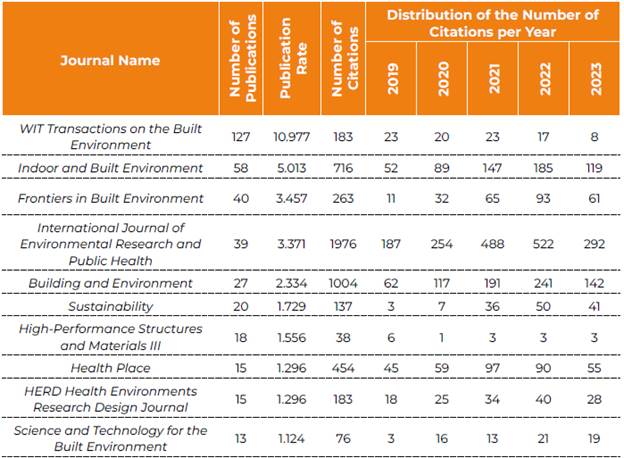
Source: authors' elaboration based on WoS database results (2023).
The publications in Indoor and Built Environment were shaped by construction technology, engineering and public environment, and occupational health issues. Publications on construction and engineering were also made in Frontiers in Built Environment. The International Journal of Environmental Research and Public Health included environmental sciences, ecology, public environment, and occupational health studies. Although the number of publications was low, citations were relatively high in the International Journal of Environmental Research and Public Health and Building and Environment.
Table 3 shows the top 10 most cited publications. The article "The Built Environment and Mental Health," published in 2003 in the Journal of Urban Health: Bulletin of the New York Academy of Medicine, ranked first with 670 citations. In the article, which was a compilation study, the effects of problems arising from crowding, noise, privacy, furniture configuration, daylight, air quality, personal control, social support, and restoration parameters in the built environment on mental health were discussed, citing information from various user groups in residential and institutional environments.
The article "Mental Health Benefits of Long-Term Exposure to Residential Green and Blue Spaces: A Systematic Review," the 2nd most cited publication with 578 citations, was published in the International Journal of Environmental Research and Public Health" in 2015. The bibliometric study aims to determine the effect of green and blue spaces on human mental health. Twenty-eight studies were reviewed, with PRISMA used to report reviews and analyses. While the study found a limited cause-and-effect relationship between adults' mental health and the green environment, the evidence was insufficient for children. Studies on the effect of blue spaces on mental health were also quite limited.
At the same time, the results obtained from different existing studies often varied depending on factors such as gender, social class, and physical activity, among others. "Environmental Preference and Restoration: (How) Are They Related?" was the 3rd most cited publication, with 479 citations. In the article published in the Journal of Environmental Psychology in 2003, the authors examined the connection between environmental preferences and psychological healing. After a horror movie, they showed the participants videos featuring the built and natural environment. They asked participants to rate these videos according to beauty, naturalness, etc. Additionally, a concentration test was performed after watching an environmental video. While natural environments were found to be more beautiful than built environments, it was determined that natural environments were better for people and increased concentration. A study revealed that emotional well-being was associated with preferring to be in natural environments.
When we examine the top 3 articles, we see that natural environments are better for people's mental health than built environments. The first study presented a broader framework regarding the built environment by touching on the parameters of the built environment.
The fact that it was literature for future studies and was one of the first studies on the subject in the early 2000s was among the reasons why it was the most cited publication. Apart from this, experimental studies in the relevant literature also attracted the attention of researchers. Notably, these studies were also related to architecture but appeared in journals scanned in medicine, psychology, health, and public health. Thus, the relationship between stress and the built environment, which started to be discussed in the late 1900s, has been closely associated with architecture in recent years.
Bibliographic Analysis Results in Architecture
When an evaluation was explicitly made about publications in architecture, it is seen that the first publication was made in 2002. Additionally, the small number of publications showed that the studies in this field were new. The increase in stress today has revealed the need for studies in this area. Again, we can see that studies in architecture increased in 2019 and 2020 (Table 4). We think that the COVID-19 pandemic that occurred worldwide during this period may be one of the reasons for the increase in the number of publications. Curfews, social distancing, withdrawal from social life, working from home, illness, and death have caused a significant increase in stress. Therefore, these situations have affected the formation of living spaces.
Table 4 Information about the field of architecture
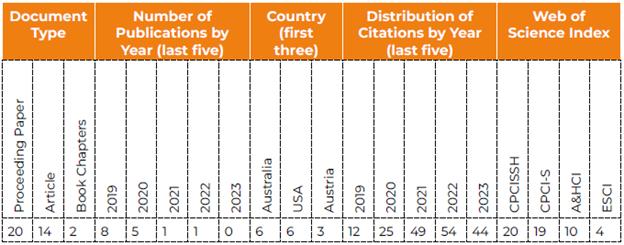
Source: Author's elaboration based on WoS database results (2023).
Another striking issue was the high number of papers. The publication of these studies in the CPCI confirms this data. When looking at the distribution of scientific studies according to documents, there were seven studies at the conference named IOP Conference Series Earth And Environmental Science," five at the conference named Sustainable Built Environment D A Ch Conference 2019 Sbe19 Graz, five in WIT Transactions on the Built Environment, four in Archnet Ijar International Journal of Architectural Research, and four in Journal of Interior Design.
Table 5 shows the top 10 most cited publications in architectural areas. The book chapter "Soundscapes, Human Restoration, and Quality of Life," the most cited among these publications, was published in 2016. The study explored the idea that access to high-quality acoustic environments may have a role in well-being, quality of life, and environmental health. A high-quality acoustic environment provided direct restoration, and the person exposed to high noise had access to quiet places in or around the house. These were the two types of restoration that the authors emphasized. Reducing noise had effects such as reducing sleep quality, blood pressure, and stress.
Table 5 Most cited publications in architecture
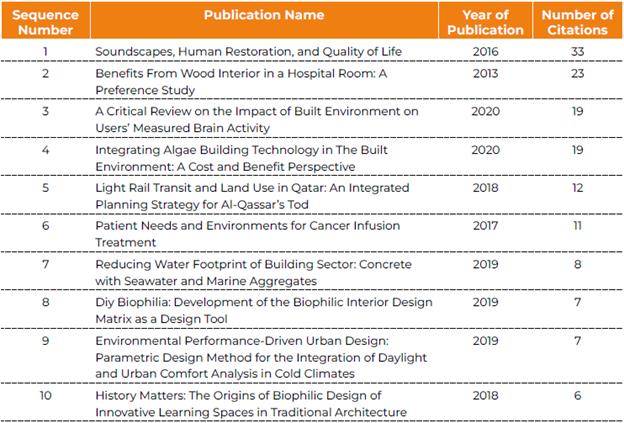
Source: Authors' elaboration based on WoS database results (2023).
The article "Benefits from Wood Interior in a Hospital Room: A Preference Study" was published in Architectural Science Review in 2014. The study touching on biophilic design was performed to investigate the preference for natural wood in patient rooms. Considering that biophilic environments would contribute to the healing effect of the physical environment, employees were asked to evaluate photographs of patient rooms with different amounts and different wood arrangements on their surfaces in a survey. Rooms with moderate amounts of wood were preferred, while all wooden surfaces were not appreciated.
The article "A Critical Review on the Impact of Built Environment on Users' Measured Brain Activity," published in Architectural Science Review in 2021, aims to investigate the impact of the built environment on the mental state of the user, focusing on measured brain activities to indicate the momentary state of mind. The study says the human brain has higher stress levels in built environments and is more meditative in natural environments. According to the literature reviewed, encouraging more research focused on design features, necessary studies to integrate nature into the built environment, and innovative designs with instantaneous brain activity measurements that can relate building function to the measured mental state will contribute to creating positive effects on the human brain. Thus, it is possible to talk about healthier environments.
Considering the studies in the top three, we can see that they are more specialized. While the first study discussed the effect of noise on stress levels, the second focused on biophilic design and mental health, and the third focused on neuroarchitecture. It is also clear that the built environment has both stress-inducing and stress-relieving potential.
Bibliographic Map Results
To determine the relationship between the authors of scientific studies using the keywords "stress" and "built environment" together, the researchers created a network map with the criterion that an author should have at least one publication and at least five citations. We identified 2,392 authors meeting this criterion. Considering the most linked authors, according to the criteria, seven clusters comprised 71 names and 327 links. Each color on the map represents a cluster, and each circle represents an author (Figure 7). The size of the circles shows that the total number of co-authorship relationships is high. Among the seven separate clusters, there are 14 co-authors in the first, 12 in the second, 11 in the third, 10 in the fourth, and 8 in the fifth and seventh. Power-Wiley, Zenk, Schulz, Tamura, Berrigan, James, and Laden stand out among these authors. The authors with the most works are Boland, Kim, Lam, Sawodny, Sobek, and Wang. There is no overlap between the most connected authors and the most published authors.
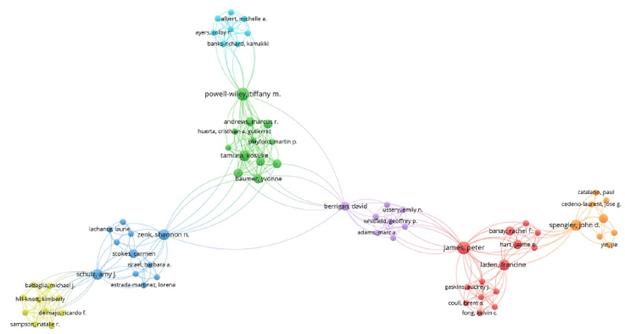
Source: visualized with Network Visualization in VOSviewer (2023).
Figure 7 Co-author network analysis of scientific publications.
To analyze the keywords used in scientific studies, a keyword must be mentioned at least five times. So, out of 3,817 keywords, 95 met the threshold. According to the criteria determined in the analysis, nine separate clusters formed 92 keywords, 490 links, and 765 total link strengths (Figure 8). In keyword network analysis, the size of the circles shows the most frequently discussed topics, while the words that come together under the same color and form clusters show that they are closely related.

Source: visualized with Network Visualization in VOSviewer (2023).
Figure 8 Keyword network analysis
According to the network map, when we analyzed the most used keywords, "built environment" was used 155 times, with 75 links and 218 total link strength. "Stress" was used 53 times, with 46 links and 93 link strength. Other keywords included "mental health" (39), "health" (31), "climate change" (31), "thermal comfort" (23), "physical activity" (23), "nature" (19), and "wellbeing" (18) (Table 6).
Table 6 Occurrences and total link strength in co-occurrence-author keywords network analysis

Source: authors' elaboration using on VOSviewer results (2023).
We distributed keyword usage by year through Biblioshiny-R Studio. When the authors examined the distribution, they saw that "quality of life" was frequently used as a keyword in 2023 in searches with a minimum frequency of five words. In 2022, "COVID-19," "heat stress," and "machine learning" came to the fore. We saw that "mental health," "well-being," and "nature" were used more frequently in 2021. The year in which the "stress," "built environment," and "climate change" concepts intensified was 2019 (Figure 9).
In the search made using "stress" and "built environment," the leading self-evaluations of scientific studies were collected in eight clusters in the thematic map made with Biblioshiny-R Studio (Figure 10). When we investigated these clusters, "stress," "built environment," and "temperature," which were included in the Motor Theme and formed the fiction of the work, came to the fore. In other words, these concepts show the themes extensively used in the literature that are highly productive in the research. "Strength" was in the Niche Theme, which includes a widely used but not central theme. This field can be more closely associated with the scientific area of engineering and construction. The themes that are developing or are about to disappear include "resistance," "communities," and "damage." It is possible to talk mainly about engineering and construction for these themes. The Simple Theme includes "behavior." This indicates that the concept is central and related to those in the motor theme but is not used intensively enough. In other words, it shows the scarcity of studies on stress in the built environment regarding human behavior.
The authors performed the citation network analysis of authors with the criterion that an author should have at least one publication and at least five citations, and they identified 2,392 authors with connections between them. Of the 1,000 authors meeting the threshold value with this criterion, there were 772 with the most connections in the network map. In the network map created with the specified criteria, we described 33 clusters between 1 and 51 authors. Among these authors, the most cited are Evans and Nieuwenhuijsen, with 670 citations, and Dadvand, Gascon, Martinez, and Triguero-mas, with 648 citations (Figure 11).

Source: visualized with Network Visualization in VOSviewer (2023).
Figure 11 Authors' citation network analysis
To visualize the network map of the citations received according to the countries where the publications were made, the analysis provided with the criterion of at least one publication and five citations in a country showed that 72 out of 84 met the threshold value and 52 were the most connected. In line with these criteria, we described 14 clusters and 173 connections, and there were between one and eight countries in the sub-clusters. When we investigated the network map, the country with the most citations was the USA, with 365 publications and 10,393 citations, followed by the Netherlands, with 55 publications and 2,499 citations; the People's Republic of China, with 154 publications and 2,423 citations, Australia with 91 publications and 1,875 citations, and the United Kingdom with 91 publications and 1,498 citations (Figure 12). When we examined the number of citations and publications in the countries, partial parallelism appeared. Although the number of publications was relatively less in the Netherlands, the number of citations was higher than in countries with more publications.
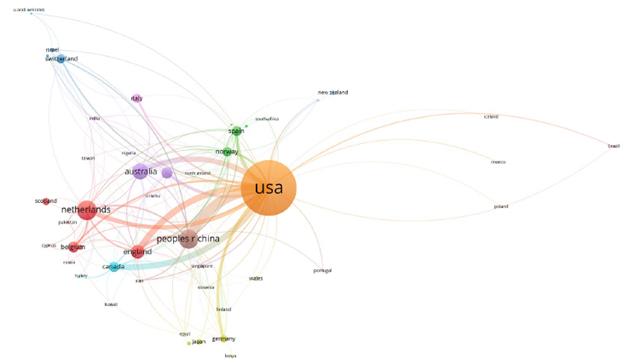
Source: visualized with Network Visualization in VOSviewer (2023).
Figure 12 Citation network analysis of countries
Researchers performed a co-citation network analysis of authors with the criterion that an author had at least five citations; 1,603 authors met the threshold value, and 1,582 having connections between them were identified. In the network map created with the specified criteria, we identified 12 clusters with between two and 338 authors. Among these authors, the most cited were Ulrich with 188 citations, Evans with 179 citations, Hartig with 162 citations, Kaplan with 110 citations, and Van Den Berg with 99 citations (Figure 13).
DISCUSSION
The authors performed a bibliometric analysis of scientific studies on "stress" and "built environment" in all fields worldwide. They analyzed the data obtained from the WoS database through VOSviewer and Biblioshiny-R Studio software. They think the study's goal of determining trends will guide future studies.
When considering the distribution according to research areas, there are many studies in the scientific area of engineering and construction. Studies in this field show that stress has meanings: tension, strength, force, etc. (Hayashi & Ohsaki, 2020; Megalooikonomou & Papava-sileiou, 2019). The scarcity of studies in architecture is striking. Filling the gap in this field with qualified studies is crucial to providing a better quality of life in built environments.
In the distribution by years, there was a jump in the number of publications in 2019. The COVID-19 pandemic is one of the most important reasons for this result, as it has created an outstanding stress burden on people. Studies on COVID-19 have increased considerably in every field globally. In addition to medicine (Geraiely et al., 2021), there are studies on areas such as environmental health (Mouratidis & Yiannakou, 2022), mental health (Amerio et al., 2020), education (Hu et al., 2022), and housing (Natomi et al., 2022). The world has just begun to recover from this pandemic.
Regarding the published indexes, the fact that half of the papers published in the SCI-EXPANDED index reveals the importance of the subject and its place in scientific studies. It also confirms that the studies arise in engineering and construction. The scarcity of A&HCI-indexed publications shows that the effects of stress on humans have been the subject of very few studies.
The country with the most publications and citations on the subject is the USA by a significant margin. A study conducted in 2018 (Fontelo & Liu, 2018) confirms that the number of publications and citations in the USA is relatively high in all fields. The country with the highest number of publications and citations on the subject is the USA, with a significant difference. Reasons such as being a very large state, hosting many universities, providing serious support for academic studies, and supporting talented scientists trained in science and technology branches to work in USA universities can be counted for this result.
Considering the density of keywords, the relationship between stress, health, and well-being stands out. In addition, we think that the studies focused on climate change and thermal comfort are due to the search for solutions to global warming, whose effects are felt more and more daily (Suhaimi & Mahmud, 2022).
When we look at the distribution of keywords by year, recent concepts focus on quality of life, COVID-19, heat stress, and machine learning, and they have attracted the attention of researchers. In addition, the concepts of climate change, mental health, and well-being have gradually emerged. Recently, there have been bibliometric studies conducted with these concepts (Öztürk Akbiyik & Arslan Selçuk, 2023; Usman & Ho, 2021). When we evaluate these concepts, we see a tendency towards design approaches that will contribute to people feeling better mentally and towards protecting and embracing nature more due to emerging pandemics, climate change, etc.
About the thematic analysis, the themes formed are more common in engineering and construction. The fact that "behavior" is close to the motor theme indicates that it is central but not dense enough. So, studies on human behavior and stress in the built environment must be increased.
When we look at the most cited publications, we encounter a comparison of built and natural environments in architecture and studies in more specialized areas such as neuroarchitecture, noise, and biophilic design.
CONCLUSIONS
The study focuses on stress, which has recently emerged as an essential concept in the built environment, and questions the equivalent of scientific studies in the literature. Thus, the relationship between stress and the built environment was revealed over time. The study handled the analyses using bibliometric analysis and bibliographic mapping.
Since stress is interdisciplinary, it has a widespread impact in many research fields. It is a pivotal concept to take the necessary precautions to reduce stress in human life in the built environment, which seriously affects the quality of life, and to continue studies that develop solution proposals. Therefore, it is thought that the study will contribute to the field.
The study has its limitations. The concepts were searched on the Web of Science, the most prominent and preferred database. Since the analysis was based on a single database, a limited number of data were examined. Research results on the database may change over time. The concept of stress is versatile. For this reason, research conducted in areas without sharp distinctions may not yield sufficient results.
In the future, conducting bibliometric analyses on the factors that cause stress in the built environment in architecture may provide a solid source for researchers. In addition, new evaluations can be made by expanding data sources by scanning different databases. Moreover, in addition to the study, the scientist can closely examine the role of stress in the built environment by conducting content analysis of prominent publications. Guidelines for designing stress-reducing environments can be developed through content analysis.














